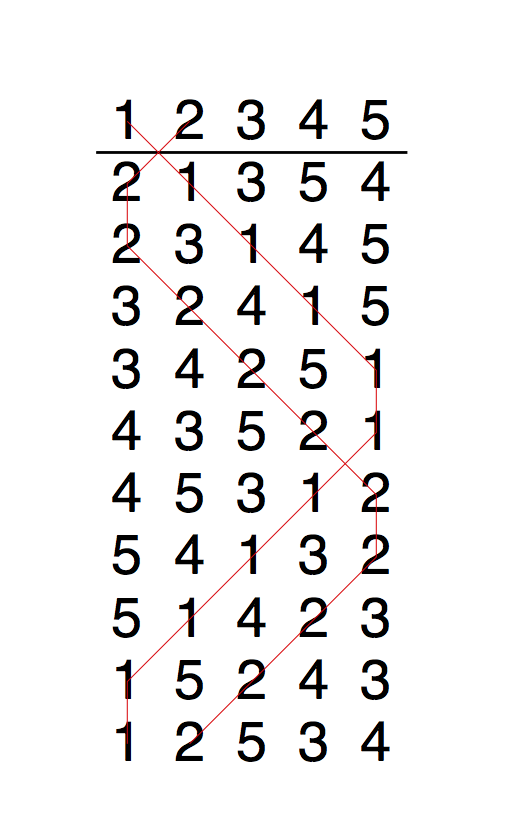08: Ringing the treble to Flying Dutchman
We’re going to make a single alteration to Plain Hunt on 5 which makes it much easier to ring on the treble.
Instead of having the 5th make 5ths for the first change, we’re going to have the 3rd make 3rds. You don’t need to worry about the effect this has on bells 3, 4 and 5.
We end up with a variation called Flying Dutchman. Here’s a diagram:

The great thing about Flying Dutchman is that the treble gets to follow bells 2, 3, 4 and 5 in order:
- Follow the 2nd in 2nds place
- Follow the 3rd in 3rds place
- Follow the 4th in 4ths place
- Follow the 5th in 5ths place
- Follow the 2nd in 5ths place
- Follow the 3rd in 4ths place
- Follow the 4th in 3rds place
- Follow the 5th in 2nds place
- Lead
- Lead
- Start again!
Try it! Knowing that you follow 2,3,4,5 in that order leaves you free to concentrate on getting the feel of the three different speeds you need:
- slow, for hunting up
- normal for lying still or leading
- fast for hunting down
Have fun! Your teacher will help you if you get a bit lost to begin with.
This video shows Grandsire Doubles being rung on the bells of Edlesborough in Buckinghamshire. Grandsire starts with a lead of Flying Dutchman, and the ringer with her back to you is ringing the treble, You have a grandstand view of what she is doing as she hunts the treble up to the back and down again, following each of 2,3,4 & 5 in that order. In subsequent leads, she passes the bells in a different order, so either stop watching at that point, or see if you can see which bells she is following. This video illustrates an important difference between our call-change and method ringing here in Vernet. We ring call changes with closed handstrokes, but we ring methods with open handstrokes. See if you can hear how the treble leaves a gap at handstroke between herself and the tenor in the opening rounds, and how that gap continues into the method. The striking isn't perfect, but it's good enough for you to be able to hear the basic idea of ringing with open handstrokes.
Once you can ring Flying Dutchman on the treble, you could try it on the 2nd. The diagram shows that the 2nd plain hunts too, starting by leading, then hunting up and down, the same as the treble. The ropesight’s a bit harder, but the order you pass the other bells in really isn’t that difficult. If you’d rather stick on the treble though, that’s fine. The next thing after Flying Dutchman will be to ring the treble to a plain course of Grandsire Doubles.
Flying Dutchman has the slight problem that it never comes back into rounds, but just keeps going for ever. If you want to know why it’s called Flying Dutchman, check this link out:



